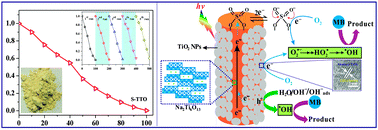S-doped Na2Ti6O13@TiO2 core–shell nanorods with enhanced visible light photocatalytic performance†
Abstract
S-doped Na2Ti6O13@TiO2 (S-TTO) core–shell nanorods, with exposed anatase TiO2 {101} facets, were synthesized by a facile calcination method. It was found that the addition of thiourea as the sulfur precursor was beneficial for the formation of anatase TiO2 with a better crystallinity and the doped sulfur atoms favorably stabilized the anatase structure. The substitution of Ti4+ by S6+ in the lattice of S-TTO gave rise to the visible light response and increased the amount of active groups typically as a hydroxyl radical adsorbed onto the catalyst surface. With the formation of the Ti–O–S bond, partial electrons could be transferred from S to O atoms. The electron-deficient S atoms might capture e− and thus inhibit the recombination of photogenerated electron–hole pairs. Meanwhile, a closely contacted interface was formed between Na2Ti6O13 and anatase TiO2, resulting in a nanoscale heterojunction structure to speed up the separation rate of photogenerated charge carriers. The exposed anatase {101} facets could act as possible reservoirs of the photogenerated electrons, yielding a highly reactive surface for the reduction of O2 to O2˙− and thus the decrease of recombination probability of electron–hole pairs. In addition, the anisotropically shaped titanate nanorods provided a pathway for the quick transport of charge carriers throughout the longitudinal direction. The combined effects of S doping, nano-heterojunction formation and morphology engineering led to an obviously enhanced photocatalytic performance for the degradation of methylene blue (MB) solution under visible light irradiation. The corresponding photocatalytic mechanism was investigated and discussed in detail. The present work may provide an insight into the fabrication of delicate composite photocatalysts with excellent performance.


 Please wait while we load your content...
Please wait while we load your content...